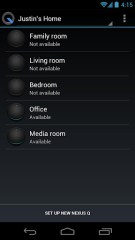Though I wasn’t expecting big news for Google TV at the Google I/O developers conference this week, I didn’t think it’d be practically ignored.
Instead of talking about Google TV at its keynotes, Google surprised its audience with the Nexus Q, a curious little orb that streams music, TV shows and movies from Google Play, or videos from YouTube. Instead of using a clunky remote, the Nexus Q is controlled by Android phone or tablet. The device is designed by Google and made in the USA; it ships in July for $299.
I don’t think the Nexus Q will be a hit. It’s expensive for a streaming media player, and the fact that Google’s not offering a way for third-party music and video services to work with the Nexus Q limits its usefulness.
But Google’s enthusiasm for the project is infectious, and it made Google TV seem like an afterthought. Google TV wasn’t discussed at either keynote, and was the topic of only three breakout sessions. (Android had 26 sessions for developers, and Chrome had 25.) Google TV was also absent from the gift bag that Google I/O attendees received, which included a Galaxy Nexus phone, a Nexus 7 tablet, a Chromebox and–wait for it–a Nexus Q.
Google’s not giving up on Google TV. The company still wants it to be the go-to platform for connected televisions, kind of like how Android is the platform of choice for most phone makers. But TV makers aren’t pledging loyalty just yet. Only Sony, LG and Vizio are making current-generation Google TV hardware, and they all continue to work on their own connected TV software at the same time. They don’t want to go all in.
Besides, Google TV doesn’t fill an obvious void in the market. If you want a connected television, you’ve got plenty of other options, and Google’s main pitch–that you can browse Internet content while watching cable or satellite TV–isn’t really a big deal.
Google TV isn’t even doing much to advance the state of human-TV interaction, as it still relies on clunky remotes with trackpads, directional pads and keyboards. Keyboard support will be mandatory on Google TV remotes until 2013, and Google hasn’t announced any plans to standardize voice controls for the platform.

And while Googlers say they want Google TV to be the Android of television, the company as a whole is moving away from the strategy that made Android ubiquitous. Consider the new Nexus 7 tablet, whose sole purpose is to get Google Play content in the hands of consumers. Google has proven willing to challenge its own hardware partners in order to promote its content.
The Nexus Q is all about the content. It uses your phone or tablet’s touch screen as an interface, so there’s no cluttered remote or confusing TV menu to deal with. Just look at the content you want, and tap. It’s like Apple TV and AirPlay, minus the unnecessary TV interface.
So here’s my prediction/ideal outcome: Eventually, the Nexus Q will support third-party services–maybe based on some of the apps that Google TV supports today. As smartphones and tablets become ubiquitous, the Nexus Q (or its descendants) will make more sense.
Meanwhile, Google TV devices will continue to flail, but maybe Google will throw its hardware partners a bone and let them integrate the Nexus Q’s technology into their televisions. The Nexus Q isn’t a great product right now, but at least it has vision. For Google TV as we know it, the Nexus Q signals the beginning of the end.

